 Russian Federation (2018-Present)
Russian Federation (2018-Present)
Infantry Fighting Vehicle – 37 Ordered
The Red Army’s Surplus
The Russian Federation is the largest and most powerful out of all the successor states of the Soviet Union. Because of this status, it inherited most of the very large fleet of armored vehicles which the Soviet Army had during the Cold War in case of a potential war against NATO and its allies. Several tens of thousands of vehicles, many of them obsolete, ended up in the hands of the Russian Federation’s Troops, with the Soviet Army’s equipment being majoritarily passed on to Russia. Upgrades have been applied to many to try and keep them relevant in modern warfare; a recent example of these upgraded Cold War vehicles is the BMP-1AM.
The BMP-1 Infantry Fighting Vehicle (IFV) is a very common vehicle in this large fleet and surplus of ex-Soviet armor. Generally considered to be the first modern infantry fighting vehicle, the BMP-1 was designed by Chelyabinsk Tractor Plant in the early 1960s, named Object 765 and later evolving into the Object 764, adopted by the Red Army in 1965. Mass-production began under the name of BMP-1 in 1966.
The BMP-1 was a welded hull, amphibious armored fighting vehicle mounting a central one-man turret armed with the 2A28 Grom 73 mm low-pressure smoothbore gun and fed by an autoloader mechanism. The vehicle also featured a coaxial PKT 7.62 mm machine gun and a 9M14 Malyutka missile launcher mounted on top of the Grom’s barrel. To the rear, a troop compartment allowed the vehicle to transport 8 dismounts.
When first pushed into service in the late 1960s, the BMP-1 was a major addition to the Red Army’s Arsenal, and despite the existence of some previous vehicles such as the West German HS.30 it is often considered to be the first truly modern Infantry Fighting Vehicle (IFV) to be adopted in massive numbers – it at least was for the Eastern Block.
The vehicle could be used to support armored assault in all types of terrains, thanks to its amphibious capacities, and was notably able to carry a section of infantry even in heavily contaminated terrain which would typically be expected after the use of NBC (Nuclear, Biological, Chemical) weapons. Support for accompanying tanks as well as dismounting infantry would be provided by a 73mm Grom infantry support gun and a Malyutka missile launcher, with four missiles stored into the vehicle, against armored vehicles. This was a considerable evolution in comparison to Armored Personnel Carriers (APCs), which typically mounted little more than a heavy machine gun.
In the Soviet Union, production of the BMP-1 lasted until 1982, with more than 20,000 vehicles produced. Almost equally large quantities were manufactured in Czechoslovakia as the BVP-1, while India produced a number under licence, and a number of countries would produce more or less identical copies (Type 86 in China, Boragh in Iran, Khatim in Sudan). Operated in massive numbers by the Soviet Army and widely exported, the BMP-1 became perhaps the most ubiquitous infantry fighting vehicle in the world, despite a more modern type (the BMP-2) entering service in the early 1980s.

With the fall of the Soviet Union in 1991, large numbers of BMP-1s ended in the hands of the new Russian Federation, but the large production run of the BMP-2, as well as the newly-produced and vastly more modern BMP-3, meant that the BMP-1 has progressively declined in the active Russian arsenal. By around 2018, most estimates placed the number of active BMP-1s at around 300 to 500 vehicles in a few motorized riflemen units, though these were also supplemented by a number of other BMP-1-based vehicles such as the BRM-1K reconnaissance vehicle. However, very large numbers of the type were sitting in reserve – around 7,000 according to some estimates.
While the point of modernizing the BMP-1 in Russia may still appear somewhat inexistant, due to the large numbers of BMP-2s already in service and undergoing a modernization process, as well as the presence of the BMP-3 and the development of the Kurganets-25, the possibility of exports is likely a motivating factor in the development of a modernization of the BMP-1. More than forty countries still operate the vehicle, including some such as India, Kazakhstan, or Egypt, who remain loyal customers of the Russian military-industrial complex and operate large fleets of the vehicle.
The Prospect of Modernizing the BMP-1
During its service and production, the BMP-1 went through a number of upgrades and new production standards. For example, in the 1970s, the BMP-1P appeared, which notably replaced the old Malyutka ATGM witha Konkurs, as well as adding a number of changes, taking lessons from experience in the Vietnam War (for example a new fire-extinguishing system in order to protect the vehicle from napalm, and new smoke dischargers)
After the fall of the Soviet Union, a number of more extensive upgrades were considered. The 73 mm Grom was now vastly considered to be an outdated weapon, lacking in firepower in comparison to infantry fighting vehicles armed with autocannons, which would, in practice, provide more efficient fire-support – particularly with larger 30mm and higher autocannons being increasingly commonly used by this point. Several different upgrades were proposed by a variety of manufacturers during the 1990s and 2000s. For example, one designed by Tula Instrument Design Bureau used the new TKB-799 Kliver turret, which mounted four Kornet ATGMs as well as a 30 mm 2A72 autocannon. Another project consisted in mounting the turret of the airborne BMD-2 IFV, armed with a 30 mm autocannon and a Konkurs missile.

The BMP-1AM is a later project. It was developed by a bureau of the large military conglomerate that is Uralvagonzavod, or simply UVZ. The first traces of a modernized BMP-1 by UVZ appeared in a report from April 2018. The vehicle would be presented in Russia’s annual military-industrial show-off, the International Military and Technical Forum ARMY, in its 2018 edition, taking place in August.
The General Design of the BMP-1AM
The upgraded vehicle which rolled out in August 2018 was far from being entirely unknown and new. Instead, it would be much better described as a mostly unchanged BMP-1 hull fitted with an already existing turret in order to enhance its firepower.

A BMP with a BTR’s Armament
The core change that differentiates the BMP-1AM from a regular BMP-1 is a replacement of the BMP-1’s one-man turret fitted with an autoloader and armed with the 73 mm Grom by the weapon station featured in the Russian BTR-82A armored personnel carrier – itself an improved version of the BTR-80A’s weapon station. This station is remotely controlled by the gunner sitting in the hull of the vehicle.
The main armament of this new turret or ‘unified combat module’ is the 30 mm 2A72 autocannon (a modified 2A42 autocannon). The cannon fires 30×165 mm ammunition. and has a rate of fire of 350 to 400 rpm. The gun is belt-fed, and overall remarkably light, weighing only 84 kg. barrel length of 2,416 mm, takes a significant part of the weapon’s weight, at 36 kg, and is typically thicker and more durable than most barrels for 30 mm autocannons.
A number of 30×165 mm shells are available for the 2A72. For use against light fortifications, infantry, soft-skinned vehicles, and other unarmored targets, the 2A72 can fire the 3UOF8 High-Explosive Incendiary (HE-I) shells. This shell has an explosive filling of 49 grams of A-IX-2, the standard Soviet explosive autocannon shell formula since 1943. The overall mass of the projectile is 390 g, and that of the whole cartridge 842 g. In high-explosive belts, it is complemented by the 3UOR6. This shell forsakes most of the explosive charge, with only 11.5 g remaining, to mount a very large tracer. Fired at the same muzzle velocity of 980 m/s, it is used for fire correction purposes, though over large distances, the trajectory of the two shells may begin to differ. With a fuse lasting 9 to 14 seconds, the explosive shells will generally detonate after about 4 kilometers if they have not met a target, though autocannons are typically used effectively at much closer ranges. The rate of tracer to high-explosive rounds in a 30 mm belt tends to be of 1:4.
For armor-piercing duties, two types of 30 mm shells exist. The older 3UBR6 is a fairly classic armor-piercing shell with a core of hardened structural steel. This steel core weighs 375 g, with the entire projectile weighing just 25 grams more, at 400 g, and the entire shell having a weight of 856 g. It features a tracer that burns for 3.5 seconds after being fired, and has a muzzle velocity of 970 m/s. Its penetration values against Rolled Homogeneous Armor (RHA) at an angle of 60° are 29 mm at 700 m, 18 mm at 1,000 m and 14 mm at 1,500 m. These are fairly mediocre performances, able to defeat little more than light armored vehicles in the vast majority of cases.
A more modern armor-piercing shell exists in the form of the 3UBR8, an Armor Piercing Discarding Sabot (APDS) shell with a tracer. It features a lighter 222 g piercing core of tungsten alloy. The projectile as a whole is 304 g, and the cartridge 765 g. Fired at a muzzle velocity of 1,120 m/s, this shell seems to penetrate, against similar RHA armor and at the same angle of 60°, 35 mm at 1,000 m, and 25 mm at 1,500 m. It offers much more promising performances than the older 3UBR6 against modern infantry fighting vehicles.

This 30 mm gun is mounted centrally on top of the turret, on a mount which may depress by -5° and elevate all the way up to 70°. This high vertical targeting means the autocannon can typically be used in limited fashion against air targets, notably helicopters.
The sight used by the gunner is the TKN-4GA (sometimes also designated ТКН-4ГА-01) sight, which can operate both in day and night conditions and is fully stabilized. As a coaxial machine gun with elevation tied to the main gun, the turret mounts the classic PKT machine gun, which has a rate of fire of 700-800 rpm firing the 7.62×54 mm Russian cartridge. On both sides of the 30 mm autocannon, the vehicle features three 81 mm 902B Tucha smoke dischargers. As on the BTR-82A, the BMP-1AM’s turret is fully stabilized. The vehicle’s weapon loadout is also considered to include a 9K115 Metis ATGM, however, this weapon system is not actually a part of the vehicle itself. It is to be carried and used by the vehicle’s dismounts.
As on the original BMP-1, the BMP-1AM’s turret is operated by a single crew member. Unlike in the original design however, this time, the turret is operated from inside the hull. This does not change the internal arrangement of the vehicle in a significant way though, due to the original turret already featuring a turret basket and an autoloader reaching into the hull.

The Vehicle’s Hull
The hull of the BMP-1AM is very similar to the one present on a classic BMP-1, keeping the form of a welded steel box with a boat-like shape towards the front to improve buoyancy, a centrally-mounted turret, a crew compartment for 8 passengers as the rear with four firing ports on each side and one on the rear left door, four hatches on top and two rear doors opening outwards and also containing fuel tanks.

The main change in comparison to the original BMP-1 comes in the form of the engine, and it is not a particularly radical transformation. The original UTD-20 engine of the BMP-1 has been replaced by its improved version already present in the BMP-2, the UTD-20S1. Both engines are identical performance-wise, featuring 6-cylinders and 4-strokes, being water-cooled and with airless injection diesel engines producing 300 hp at 2,600 rpm. The main modifications between the two are focused on making the operation and maintenance of the engine easier for the crew, including fuel drains from injectors, cover for the access hatches to the nozzle, and a system allowing for a cold-start of the engine without preparation at temperatures of -20° and higher.
The BMP-1AM also features a new radio. The old R-123M has been replaced by a R-128-25U-2 with a communication range of up to 40 km.
It also has a new internal communication system AVSK-2U.

Outside of this new engine and radio, the vehicles being modernized saw their transmissions and chassis revised and repaired to an optimal state; this also included new, more power efficient torsion bars. Small ‘wings’ have been added on the front of the side mudguards in order to mildly improve amphibious performances. Besides those changes, the BMP-1AM seemingly remains identical to the original BMP-1, keeping the same configuration of three crewmen (commander, driver, and gunner) and eight passengers. Overall, the BMP-1AM retains a lot of the old shell and capacities of the BMP-1, with upgrades in a few critical fields. The new turret and equipment resulted in the vehicle’s weight rising to 14.2 tonnes from 13.2.
A Vehicle Presumed to be Designed for Export, Pressed into Russian Service
When it was first presented in August 2018, the BMP-1AM was given the name “Basurmanin”. This name roughly translates to “pagan”. This had, at the time, been thought as a detail that pointed towards the theory that the BMP-1AM upgrade had been designed for export – which seemed a likely conjecture, seeing as the BMP-1 was rapidly fading from service in Russian service in favor of the BMP-2, BMP-3 and, in the future, the Kurganets-25.
However, in 2019, confirmation came that the BMP-1AM was actually entering service with the Russian Army. In early June 2019, Defence Minister Sergei Shoiguaffirmed that the Russian Army would receive 400 modernized combat vehicles in 2019. This total included T-72BM3s, T-80BVMs, and T-90Ms, but also the BMP-1AM “Basurmanin”, serving as a confirmation that the type was entering Russian service.
The BMP-1AM also made an appearance in the ARMY-2019 and ARMY-2020 exhibitions, showing the type was still being offered.
In late June 2020, the active production status of the BMP-1AM Basurmanin was confirmed, as photos of a train loaded with about twenty vehicles, taken in Barnaul, western Siberia, appeared on Russian and later Western social media. As of October 2020, the orders for the type are now known to have been limited to 37 vehicles for Russian service.

The BMP-1AM into Ukraine
On February 24 2022, Russia launched an all-out invasion of Ukraine, with Russian forces entering the country from Belarus, Russia, the self-proclaimed Donetsk and Luhansk’s people’s republics, and Crimea. This invasion obviously saw massive use of Russian armor, however it went worse than many would have expected.
BMP-1AMs were seemingly not spotted in almost two months of conflict. Considering the large quantity of footage available from the conflict, it is likely they were not deployed early in the war, or at least not near active combat zones. Some BMP-1P which have not been through the 1AM upgrade have however been seen. A number of these were in service with the Donbass separatists, but to some people’s surprise, there have been a few in service with the Russian Army in areas where separatists seemingly do not operate, such as Chernihiv Oblast.
From footage of Russian forces operating in Kupiansk, in Kharkiv Oblast, east of the city of Kharkiv, it appears the BMP-1AM was first seen around April 21 or 22 2022. At the time of writing (April 24 2022), only one vehicle has been identified, but considering the small scale of the BMP-1AM fleet, it is likely many if not all or them are deployed within the unit that used this vehicle. The BMP-1AM was known to be used by an unit operating in Siberia or the Far-East, suggesting an unsurprising redeployment to Ukraine. Many units were already moved from other parts of Russia to the Ukrainian border prior to the invasion even happening.
The blog posted by Oryx documenting Russian equipment losses during the 2022 Russian invasion of Ukraine, suggests that, two months into the conflict, more than 500 vehicles have been destroyed, incapacitated, or captured, and human losses, while widely debated, likely are very significant as well. The deployment of more ‘fresh’, even if not necessarily well-equipped, units is at this point (April 2022) likely a necessity for Russia if it wants to push into eastern Ukraine. Vehicles spotted alongside this BMP-1AM in Kupiansk include T-90As, T-72Bs, BMP-2s, MT-LBs, and a myriad of trucks.

The BMP-1AM into Combat
As a result of the BMP-1AMs deployment in Ukraine, combat footage has begun to appear on the internet. The first example (at least as far as the author can attest to) was a video shared on Telegram and later on other parts of the internet more largely from 1st May, very briefly showing a BMP-1AM firing its 30 mm main gun. The vehicle spotted a “Z” marking instead of the “V” seen on the first BMP-1AM identified in the conflict.

A few days later, much more extensive footage would emerge. On May 8, footage of a Russian disastrous river crossing attempt in Siversk, Donetsk Oblast, was shared by Ukrainian media. Alongside precious specialist vehicles, such as three PP-2005 truck-based floating bridges, an IMR-2 T-72 based engineering vehicle, a tugboat, and a PTS-3 amphibious transport, two BMP-1AM were also lost, seemingly the only combat vehicles lost at this location. The two vehicles were abandoned in the river, in what appears to be very shallow water or somehow still floating. It is unclear if they received any major damage or not, but if so it does not appear immediately apparent. One of the two vehicles significantly differs from the first BMP-1AM seen in terms of markings, with two “Z” letters instead of the “V”.
Further footage from the same location appears to show a much more damaged vehicle that, unlike the other two, has its rear submerged. Though the photo is not the best, this vehicle appears to have the same turret and a similarly-shaped hull, and thus very likely is a BMP-1AM. In the following months, occasional BMP-1AM losses would continue to mount up. As of early October, the current total recorded by Oryx Blog is of 16 BMP-1AM lost, of which 10 were completely destroyed. Two were captured by Ukrainians forces in a damaged state.



Conclusion – A Modernization with an Unclear Future
The BMP-1AM stands as a notable modernization program – the first major overhaul of the old BMP-1 undertaken ever since the BMP-1P or BMP-1D of the 1970s and 1980s. It is both a non-negligible but also questionable upgrade. While it entirely replaces the turret of the BMP-1, it brings only very limited changes to the old vehicle’s hull. Though the 30 mm gun appears to be a weapon more suited to modern battlefields than the 73 mm Grom, the vehicle also loses the ability to fire anti-tank missiles from the protected interior of the vehicle – with the ATGM capacity now reposing on the dismounting infantry’s Metys missile launcher. Even though it is a late 2010s modernization, the BMP-1AM remains a second-zone IFV, which pales in comparison to even the early 1980s BMP-2, let alone new Russian products which were previously thought to be on their way to totally phase out the BMP-1 in the Russian Army’s arsenal.
The size of the vehicle pool concerned by the BMP-1AM modernization also remains very small – merely 37 vehicles were ordered, and as of now it is unknown if any further orders of the type are to be undertaken.
Another reason for giving a green light to the modernization of the BMP-1s might be the tight defence budget. The Russian MoD simply has no money to replace all of the obsolete materiel, hence the interim solutions to somehow rearm military units at the secondary theaters, such as the Mongolian border. As of 2022, this interim solution, as many others Russian armored fighting vehicles, including some uncommon one, is now finding itself thrust onto the battlefield as the Russian Army attempts an invasion of Ukraine.
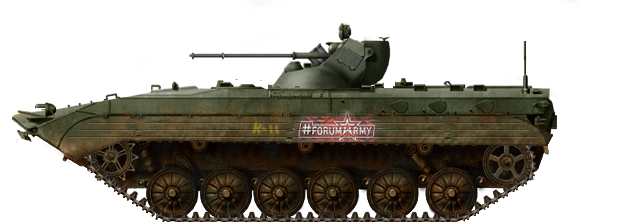
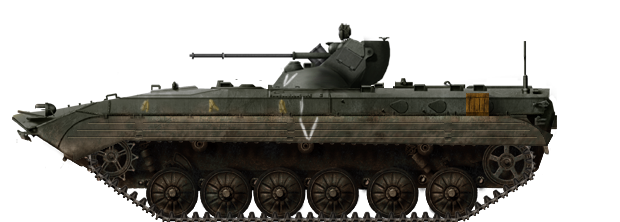
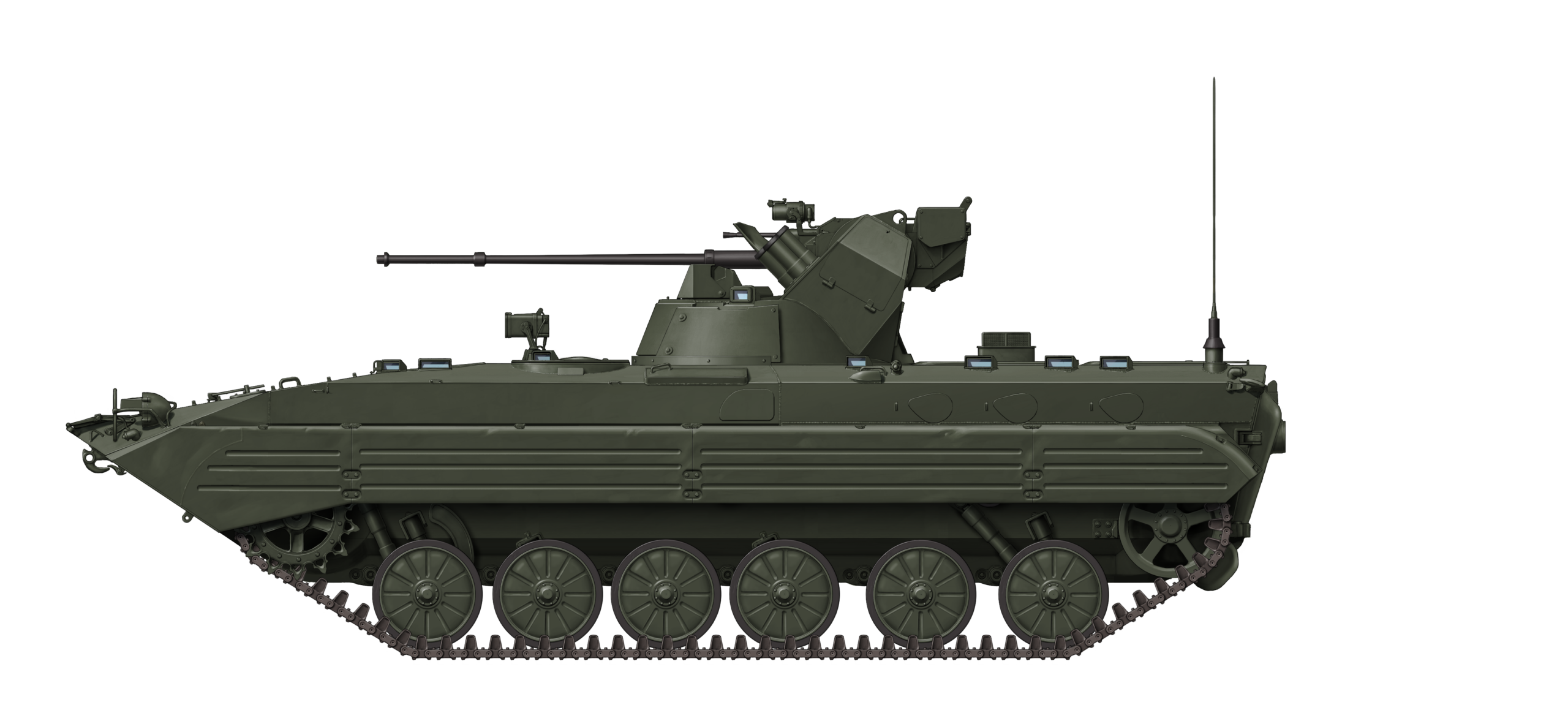
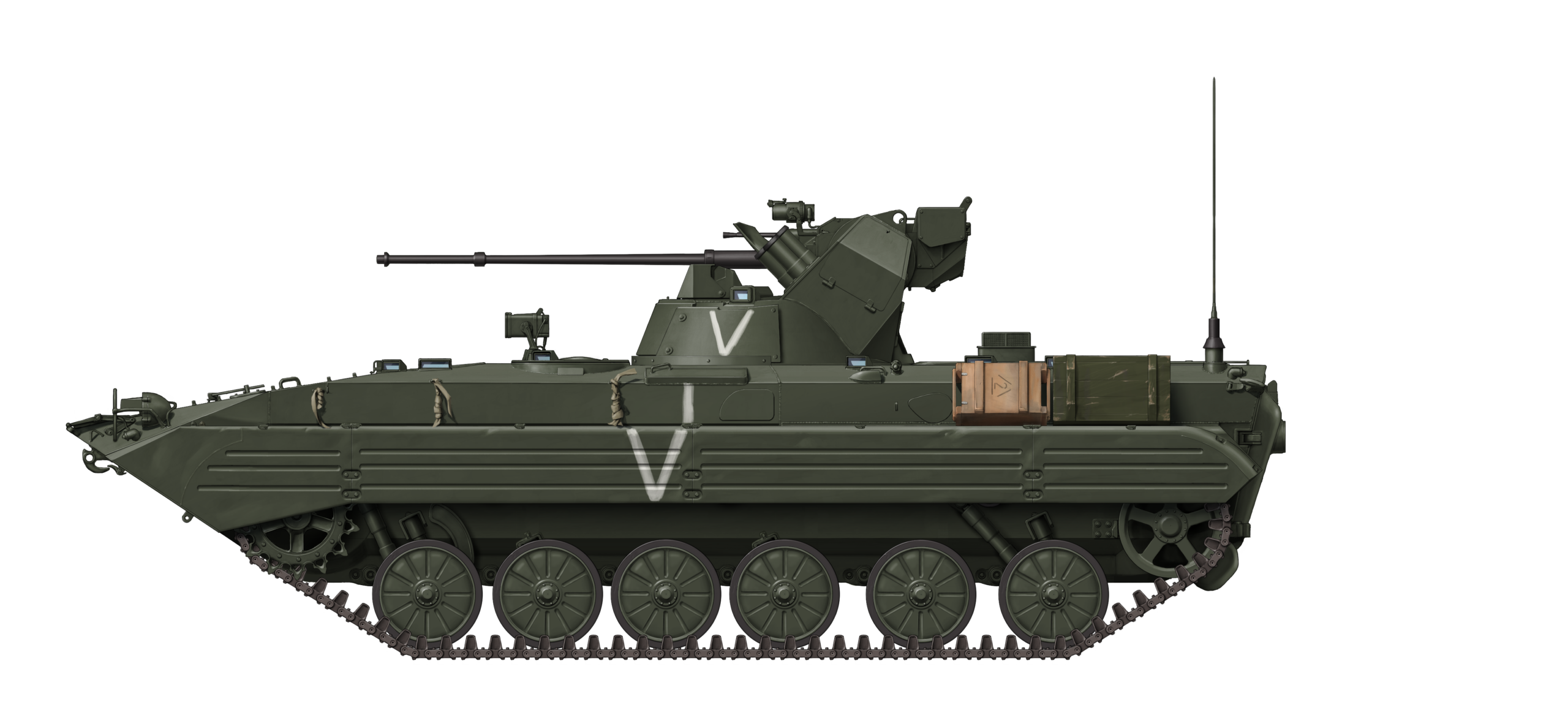
BMP-1AM specifications |
|
| Dimensions (l-w-h), m | 6.735 – 3.150 – 2.250 |
| Road clearance, mm | 420 |
| Weight | 14.2 metric tonnes |
| Engine | UTD-20S1 6-cylinder 4-stroke V-shaped airless-injection water-cooled diesel (300 hp at 2,600 rpm) |
| Suspension | Torsion bars |
| Maximum speed, km/h (road) | 65 |
| Maximum speed, km/h (water) | ~7-8 |
| Operationnal Range | ~550 km (road) |
| Fuel capacity | 420 l |
| Crew | 3 (Commander, gunner, driver) |
| Dismounts | 8 |
| Radio | R-128-25U-2 |
| Main armament | 30 mm 2A72 autocannon Metis ATGM |
| Secondary armament | 7.62 mm PKTM |
| Armor | ~19 mm maximum |
| Obstacle crossing – Climb – Trench – Wall |
– – 35 deg – 2.5 m – 0.7 m |
Sources
Tankograd:
https://thesovietarmourblog.blogspot.com/2017/03/field-disassembly-bmp-1.html
https://thesovietarmourblog.blogspot.com/p/30x165mm-cartridges.html
https://thesovietarmourblog.blogspot.com/2016/05/bmp-2.html#mob
https://thesovietarmourblog.blogspot.com/2014/10/bmp-3-underappreciated-prodigy.html
ArmyRecognition:
https://www.armyrecognition.com/weapons_defence_industry_military_technology_uk/bmp-1_upgrade_to_extend_life_cycle_in_bmp-1am_variant_-_part_1.html
https://www.armyrecognition.com/army-2018_news_russia_online_show_daily/army-2018_new_bmp-1am_tracked_armored_ifv_fitted_with_btr-82a_30mm_turret.htmlOvertDefence:
https://www.overtdefense.com/2019/06/24/russia-is-modernizing-the-bmp-1/
Topwar.ru:
https://en.topwar.ru/176409-ot-bazy-do-basurmanina-problemy-modernizacii-bmp-1.html
https://en.topwar.ru/147643-bmp-1am-basurmanin-praktichnaja-modernizacija.html
https://kad.arbitr.ru/Document/Pdf/4817e4e9-f151-4cdc-87d0-eb1d2e99981c/37d41749-703a-4030-b167-aaa992676b2f/A40-81475-2020_20201026_Reshenija_i_postanovlenija.pdf?isAddStamp=True
The source with the statement about 1000 BMP-1 in service
https://nvo.ng.ru/armament/2020-10-22/1_1114_armament1.html
The first spec sheet
http://bastion-karpenko.ru/bmp-1-basurmanin/

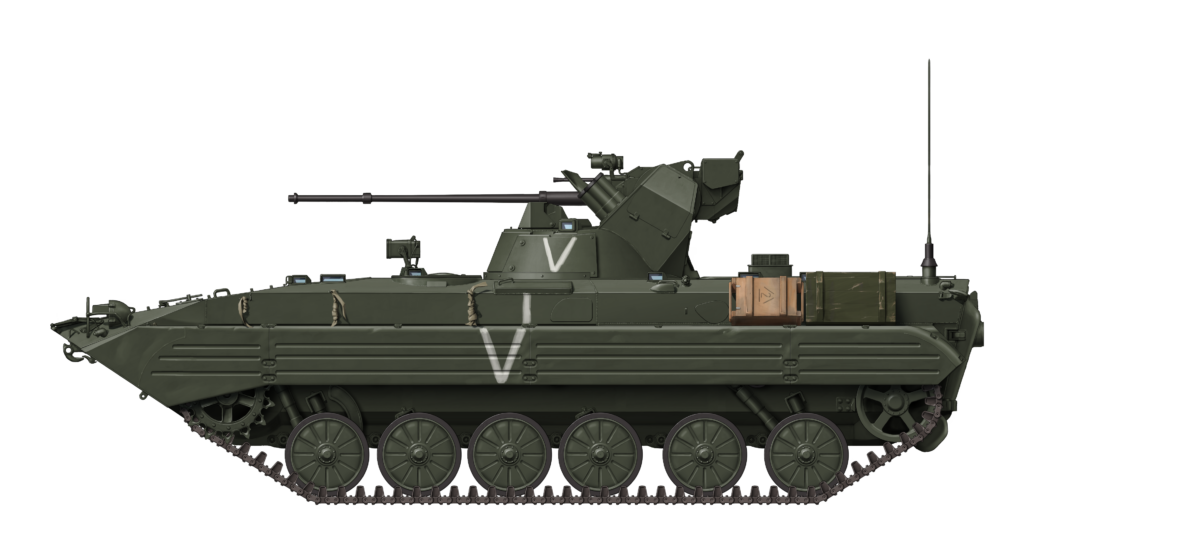
2 replies on “BMP-1AM”
As development and full scale production of new vehicles like Kuganetz will take time and generous funding, this seems to be annother stop gap messure. Just like T-72B3 instead of T-14…
As of 13 November 2023, 37 BMP-1AM are destroyed, damaged or captured. So there is a high chance there was an additional order in 2022. It is highly unlikely that 37 of 37 existing would be visually confirmed lost or damaged.